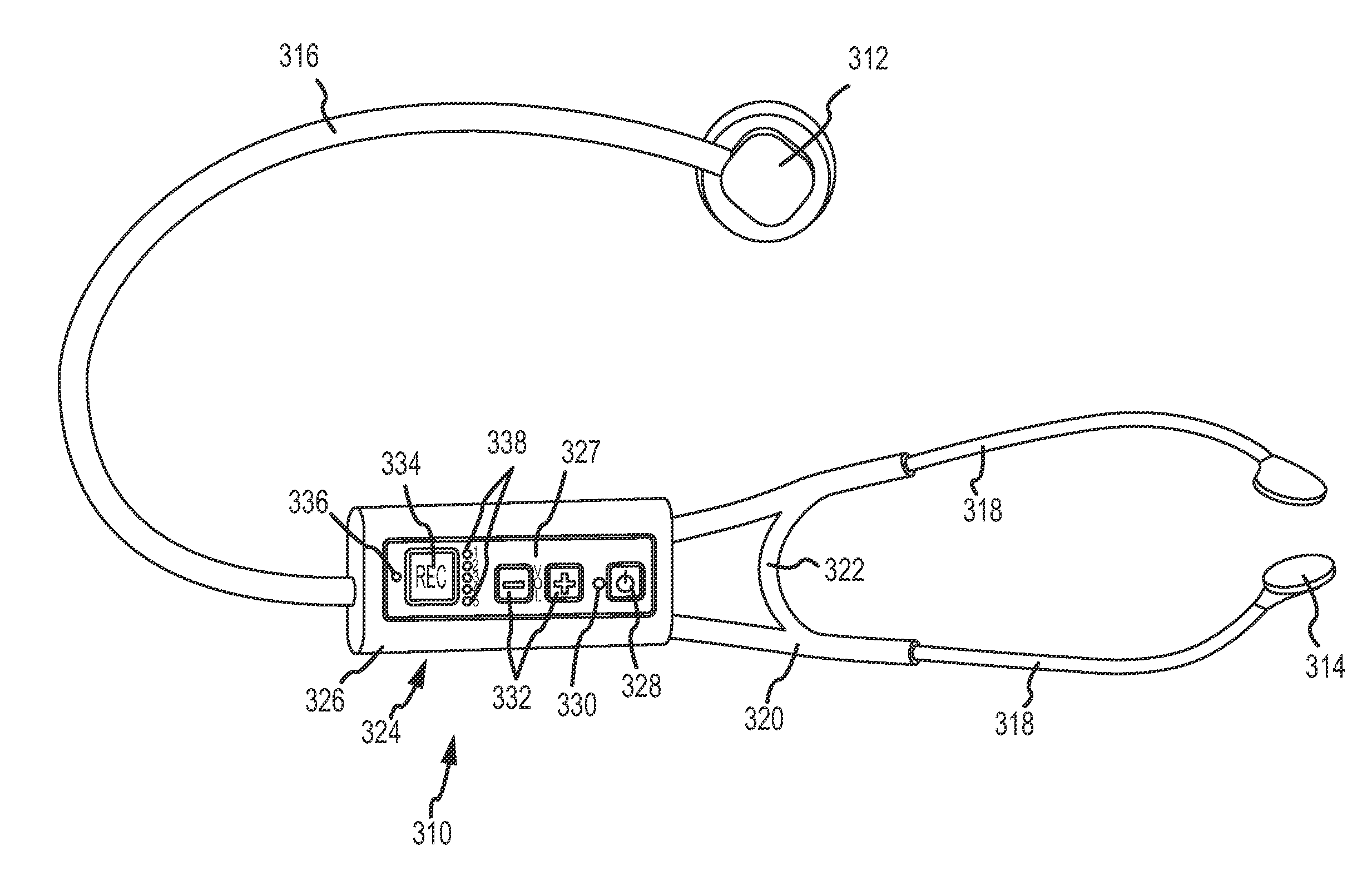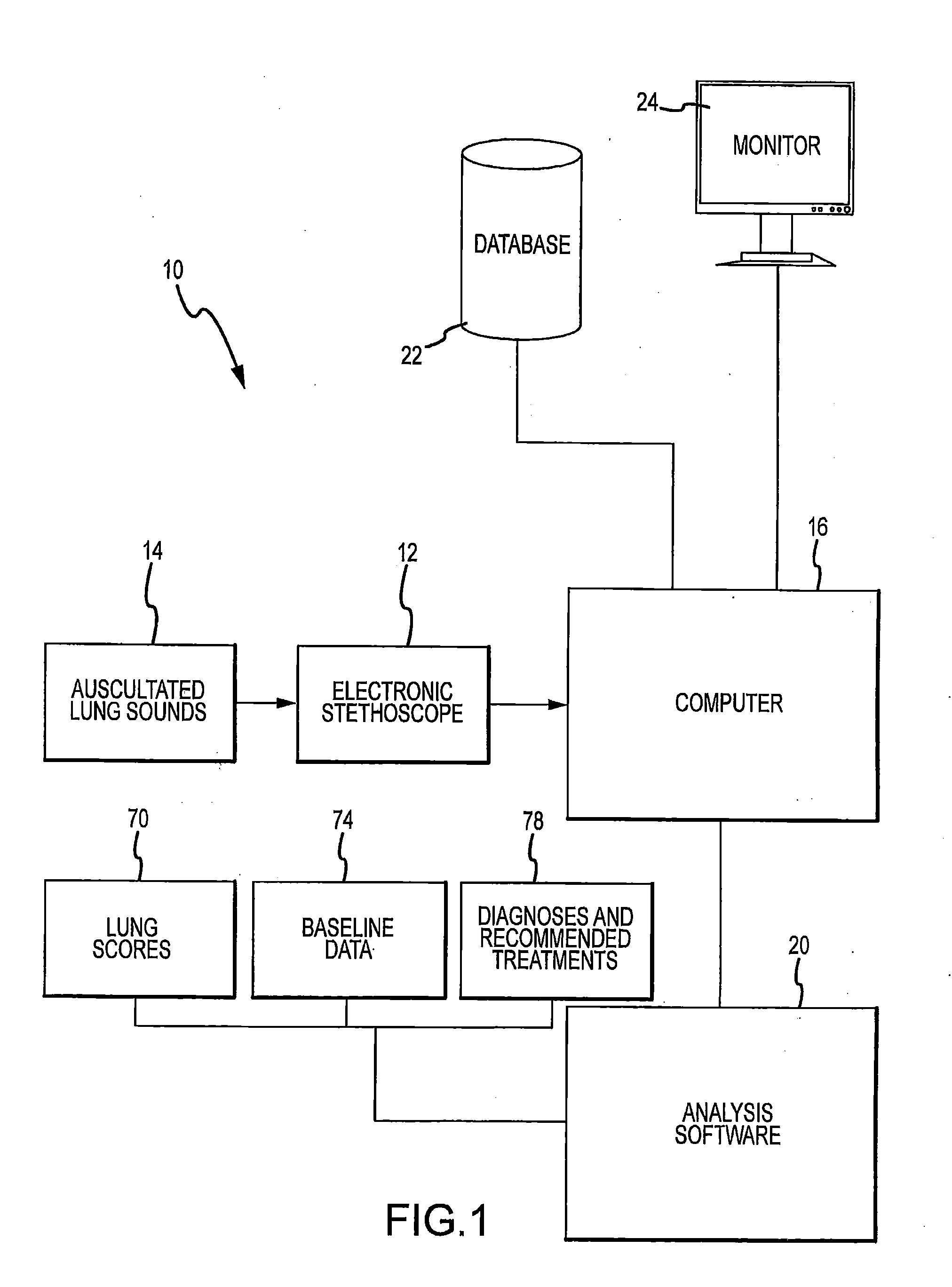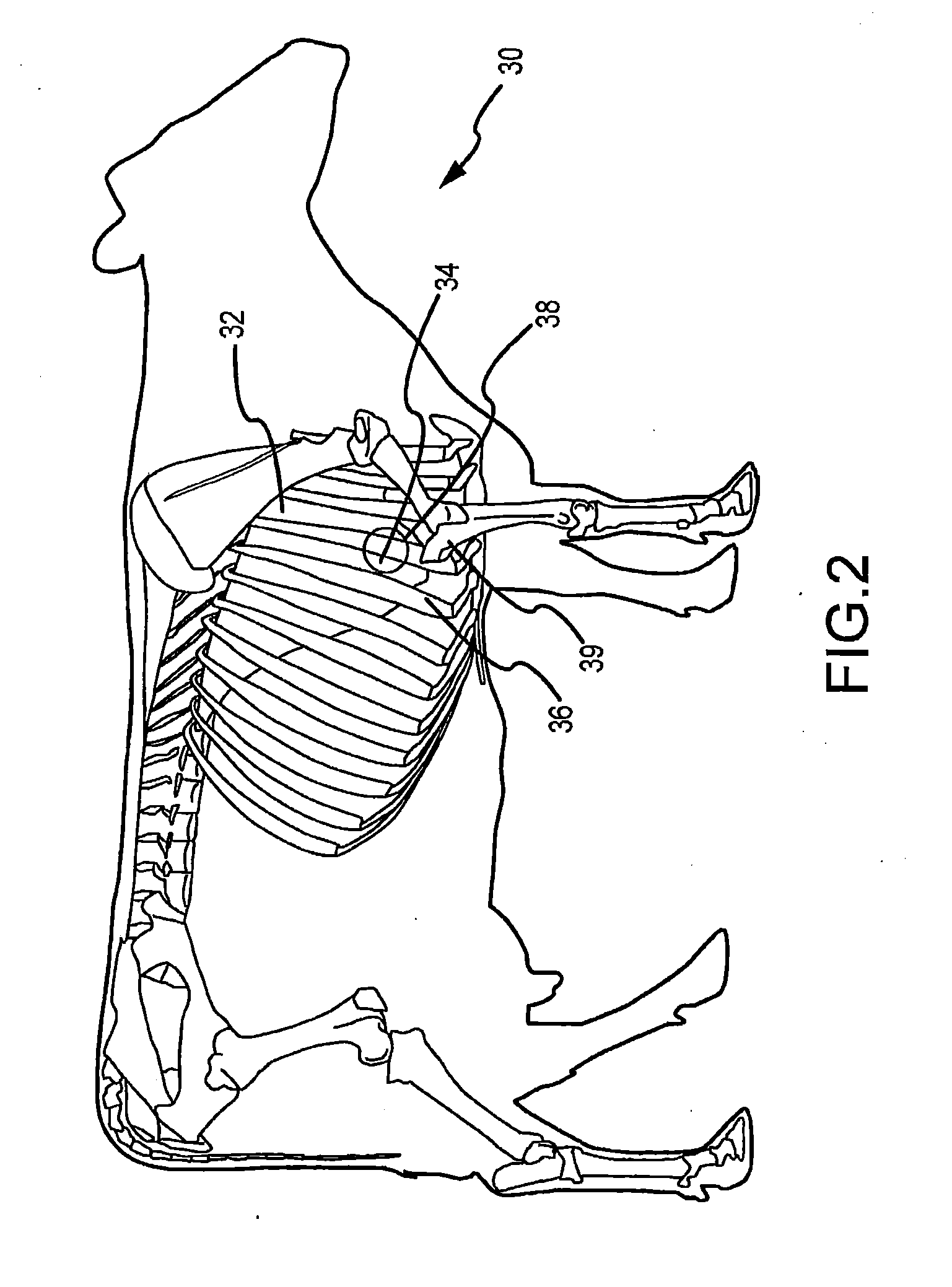[0013]In accordance with the present invention, a system and method are provided for diagnosing respiratory diseases of
bovine species. Stethoscopic evaluation of bovine lung sounds is used to gather data on the sounds. Collection of lung sounds is preferably obtained by a digital /
electronic stethoscope that is capable of expressing sounds in the form of a
spectrogram. Collected
digital data from the stethoscope is manipulated by
computer software that allows
real time analysis of the
spectrogram and the diagnosis of an ailment based upon numerical lung scores that generally categorize the health of the animal. The lung scores are compared with threshold levels that generally describe the health of the animal and can be further interpreted to correspond to a certain level of
disease in the animal. This comparison may also be used to generate one or more recommended treatments. The assigning of numerical lung scores to evaluated cattle is an efficient predictor of respiratory problems.
[0016]In accordance with the method of the present invention, the auscultated sounds are collected from
bovine species by use of a digital stethoscope that is placed approximately three inches above the
right elbow of the animal, thereby placing the stethoscope over the right apical lobe. Sounds can also be gathered on the left side approximately three inches above the
left elbow, thereby placing the stethoscope over the cardiac lobe. Once the sounds have been gathered and recorded by the digital stethoscope, the data is downloaded to a computing device. The recorded sound is preferably loaded as a .wav file. If another
file format is used, in accordance with the present invention, the
software is adapted to convert to the .wav format for
processing. A .wav file is an
industry standard waveform audio format that is used for storing audio on devices such as personal computers. This file is a variant of the RIFF bit-
stream format method for storing data in groups, and is presently the main format used on Windows systems for raw audio data. The data recorded from the sound is stored in an array in its raw or basic format. A short-time
Fourier transform (STFT) is performed on the
raw data with a selected window size of approximately 512 data points and an approximate 50% overlap. The window size refers to the amount of data that each
Fourier transform will cover. Each window is overlapped with approximately 50% of the previous window to help improve
frequency resolution. Because a
Fourier transform functions only with an infinite stationary
signal, the dynamic signals recorded have to be separated into many small pieces so that each piece can represent a stationary value at that time. The window size selected has an effect on how accurate of a frequency representation the transform outputs, and a window size of approximately 512 data points has been shown to provide the requisite accuracy for purposes of generating lung scores in accordance with the present invention. For example, sounds sampled at 4000 Hz by a particular type of digital stethoscope could contain 8192
raw data points for every second of recorded sound. The STFT will take the first 512 of these data points and operate on them. The second sweep, because of the overlap, will start at the 256th
data point and progress to the 767th
data point. This combination of window size and overlap has been shown to provide a good
trade off between
frequency resolution and
time resolution.
[0017]Through testing, it has been found that the specific windowing function may include a Hamming function. As understood by those skilled in the art, a Hamming function zeroes the data outside of a specified interval. Windowing functions are used in short time Fourier transforms (STFT) to help combat the problem of
spectral leakage. The Hamming function has been shown to help create better
frequency resolution, such that the frequencies contained in the recorded sound can be more accurately represented.
[0042]Additional filtering techniques may be used to improve analysis of the recorded sounds. Three additional filters that can be used to eliminate interfering sounds include a
heartbeat reduction filter, an adaptive bandstop filter, and a pop / crackle filter. The
heartbeat filter is based on an adaptive threshold piece wise interpolation technique that is used to eliminate the
noise associated with the
heartbeat and that can otherwise interfere with recorded lung sounds. The adaptive bandstop filter is based on the same technique as the heartbeat filter, but is instead focused on eliminating any interference
noise emitted at a
constant frequency throughout the recorded sound, such as the
noise generated by a cattle chute. The pop / crackle filter is used to eliminate any remaining pops or
crackles associated with stethoscope movement that remain on the user selection screen.
[0044]Also, the spectrograms assist a caregiver in further analyzing the particular
pathology associated with the animal since there may be other indications within the
spectrogram that assist the caregiver in making a diagnosis. For example, comparing the amplitudes of the recorded sounds during
inhalation and
exhalation can also be an indicator as to a particular respiratory condition.
[0046]In another embodiment of the invention, an electronic digital stethoscope is provided with an integral display that enables a user to view the lung
score directly on the device or to view some other visual indication of the state of the animal's health. In one aspect of this embodiment, it is contemplated that the stethoscope has a
wireless capability to communicate wirelessly with a
remote computer. The computer receives a digitized
lung sound from the stethoscope. A selected
algorithm is applied to this digitized data on the computer, and a lung
score or some other tangible output is produced that provides an indication of the animal's health. This output is then sent wirelessly back to the stethoscope for display for the user. In another aspect of this embodiment, it is contemplated that the digital stethoscope itself may incorporate a
microprocessor, associated memory, and
software or
firmware that is capable of generating the lung score or some other output indicative of the health of the animal. Thus, the sounds recorded by the stethoscope are manipulated by the
microprocessor to generate the lung score output or another output indicating the
animal health, and a
remote computer is not necessary.
 Login to View More
Login to View More  Login to View More
Login to View More 


